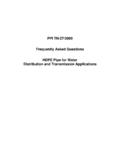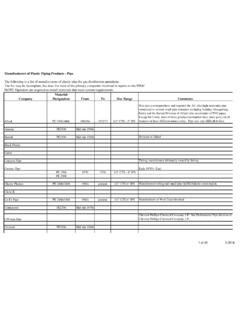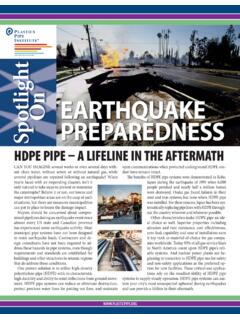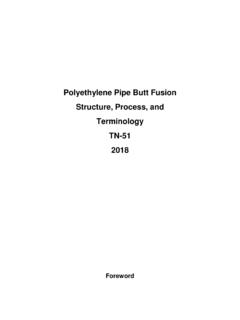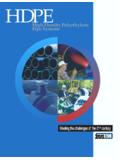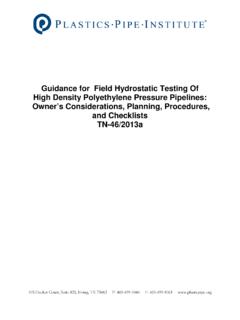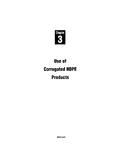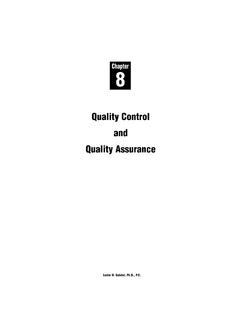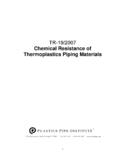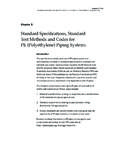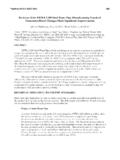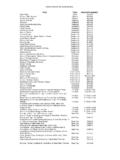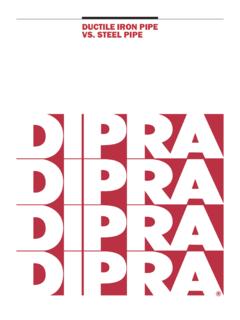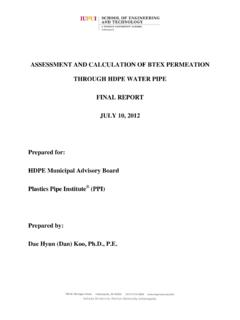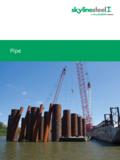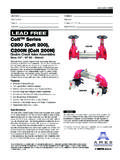Transcription of Permeation of Water Pipes and on the AWWA-RF …
1 Plastics pipe Institute Page 1 PPI Comments on Permeation of Water Pipes and on the AWWA-RF report on Hydrocarbons March 16, 2009 Water utilities want to maintain a high standard of Water quality and to protect the Water from any internal and external contaminates. The awwa Research Foundation ( AWWA-RF ), now known as the Water Research Foundation, recently published a report entitled Impact of Hydrocarbons on PE/PVC Pipes and pipe Gaskets which reviewed the susceptibility of different piping systems to Permeation of organic compounds.
2 The polyethylene pipe industry did not have an opportunity to comment on the report prior to its publication. Because information in the report relevant to the susceptibility of polyethylene pipe to hydrocarbon penetration needs additional clarification, the Plastics pipe Institute, Inc., has issued this statement clarifying some points to ensure that the AWWA-RF report is not misinterpreted by engineers and specifying officials. For more information regarding PE pipe , contact Camille Rubeiz, PE, Director of Engineering, It is clear from the report that all piping systems appear to have some potential for contamination from external agents through Permeation of gaskets, jointed connections or Permeation through the pipe wall.
3 The report concluded, however that the overall impact of hydrocarbon Permeation is relatively small and stated that the incidents of Permeation of Water distribution systems is rare, citing less than one reported incident per 14,000 miles of Water mains and less than one incident per million service line connections. The awwa has addressed concerns regarding hydrocarbon Permeation by including a Permeation statement in all of its pipe standards including standards for polyethylene (PE) (C901-02 p. 5, C906-07 p. 6), polyvinyl chloride (PVC) (C900-07 p.)
4 6, C905-97 p. 3), steel (C200-05, p. 7), ductile Iron (C110-03, p. 3), and others. Although, literature suggests that Permeation of organic chemicals and hydrocarbons through polyethylene (PE) pipe is possible, actual cases of soil contaminated hydrocarbon Permeation are extremely rare as noted in the AWWA-RF report and summarized here. The mechanism of hydrocarbon and solvent Permeation through a pipe is complex due to the many variables that may exist in a situation where Permeation is possible. Some of the variables are: soil type and texture; interaction and concentration of contaminates with temperature; rate and extent of diffusion of contaminate into the pipe wall and joint; effect of pipe diameter, wall thickness and flow rates.
5 Plastics pipe Institute Page 2 When gross hydrocarbon contamination of soil surrounding pipe is a concern, there are several ways to address this issue, including: Surround the pipe with good clean soil of Class I or Class II materials to allow the hydrocarbons that may have contacted the pipe s wall to dissipate into the atmosphere and in the envelope of the surrounding soil. The US EPA guidelines prohibit the reuse of excavated hydrocarbon contaminated soil in the envelope of bedding or backfill material.
6 Sleeve the pipe in areas where active hydrocarbon contamination is known to exist. hydrocarbon contamination plumes are relatively compact and usually less than fifty feet in length. Reroute the pipe around the contaminated plume. Hydrocarbons do not degrade polyethylene but can diffuse through the wall of PE pipe in areas of gross contamination. The exterior contact may affect sidewall fusions and or butt fusions; thus, after PE Pipes have been exposed to grossly contaminated soils, mechanical connections may be preferred.
7 Again, the incidence of hydrocarbon Permeation of PE potable Water pipe is rare. Although measures need to be taken to limit the impact of hydrocarbon Permeation in grossly contaminated soils, the vast majority of PE Water pipe installations will never be impacted by hydrocarbon Permeation . 1. The AWWA-RF report indicates that gasketed Pipes including PVC and DI have demonstrated instances of Permeation . Page XXIC, Table : After 8 hours of stagnation in direct contact with gasoline, benzene MCL exceeded in Pipes < 24 using SBR and Pipes < 10 using NBR gaskets.
8 Page XXV, Par. 6: PVC Pipes that become permeated with hydrocarbons should be replaced (if they have not burst due to loss of physical strength) because remediation of the pipe is not feasible. Page XXVI, Par. 6: In a service line where periods of stagnation occur, the 5 ppm MCL for benzene was predicted to be exceeded during an 8 hour stagnation period for SBR gaskets in contact with free product gasoline. Page XXVI, Par. 8: Permeation of gasoline through PVC Pipes with SBR and NBR Rieber gaskets was rapid with breakthrough of benzene in 21 days.
9 The MCL for benzene (5 ppm) was exceeded at breakthrough. Page XXVII, Par. 1: After 8 hours of stagnation in contact with free product gasoline, the concentration of benzene in Pipes of diameters up to 24 inches using SBR gaskets was predicted to exceed the MCL. Under the same conditions, the MCL would be exceeded in Pipes of diameters up to 10 inches using NBR gaskets. In Pipes of diameter > 12 inches with NBR Rieber gaskets, the concentration of benzene was not predicted to exceed the MCL. Plastics pipe Institute Page 3 Page XXVIII, Par.
10 4: For conditions of 8-hour stagnation in contact with free product gasoline, the MCL was predicted to be exceeded for Pipes using SBR Rieber gaskets up to 24 inches in diameter and for NBR Rieber gaskets up to 10 inches in diameter. Page 2, Par. 6: In a national survey done for AwwaRF (Thompson and Jenkins 1987), 43% of reported Permeation incidents in the US involved PB pipe , 39% involved PE pipe , and 15% involved PVC.. Page 3, Par. 1: BTEX and chlorinated solvents also soften PVC pipe .., thereby causing it to be susceptible to Permeation in a manner similar to PB and PE.
